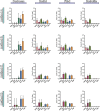Phytocannabinoids Profile in Medicinal Cannabis Oils: The Impact of Plant Varieties and Preparation Methods
- PMID: 33364946
- PMCID: PMC7751640
- DOI: 10.3389/fphar.2020.570616
Phytocannabinoids Profile in Medicinal Cannabis Oils: The Impact of Plant Varieties and Preparation Methods
Abstract
Cannabis (Cannabis sativa L.) is a highly promising medicinal plant with well-documented effectiveness and growing use in the treatment of various medical conditions. Cannabis oils are mostly used in galenic preparations, due to their easy adjustment of the administration dose, together with the enhanced bioavailability of its active compounds. As stated by the Italian Law (9/11/2015, 279 Official Gazette), "to ensure the quality of the oil-based cannabis preparation, the titration of the active substance(s) should be carried out." This study aims to represent the Italian panorama of cannabis oils, which were analyzed (8,201) to determine their cannabinoids content from 2017 to 2019. After application of the exclusion criteria, 4,774 standardized cannabis oils were included, which belong to different medicinal cannabis varieties and prepared according to different extraction methods. The concentration of the principal cannabinoids was taken into account dividing samples on the basis of the main extraction procedures and cannabis varieties. According to this analysis, the most substantial variations should be attributed to different cannabis varieties rather than to their extraction protocols. This study may be the starting point of preparatory pharmacists to assess the correct implementation of the preparation procedures and the quality of the extracts.
Keywords: cannabinoids; chemometrics methods; medical cannabis; pharmaceutical chemistry; phytochemistry.
Copyright © 2020 Dei Cas, Casagni, Casiraghi, Minghetti, Fornasari, Ferri, Arnoldi, Gambaro and Roda.
Conflict of interest statement
The authors declare that the research was conducted in the absence of any commercial or financial relationships that could be construed as a potential conflict of interest.
Figures







References
-
- Bettiol A., Lombardi N., Crescioli G., Maggini V., Gallo E., Mugelli A., et al. (2019). Galenic preparations of therapeutic Cannabis sativa differ in cannabinoids concentration: a quantitative analysis of variability and possible clinical implications. Front. Pharmacol. [Epub ahead of print]. 10.3389/fphar.2018.01543 - DOI - PMC - PubMed
LinkOut - more resources
Full Text Sources
Research Materials

